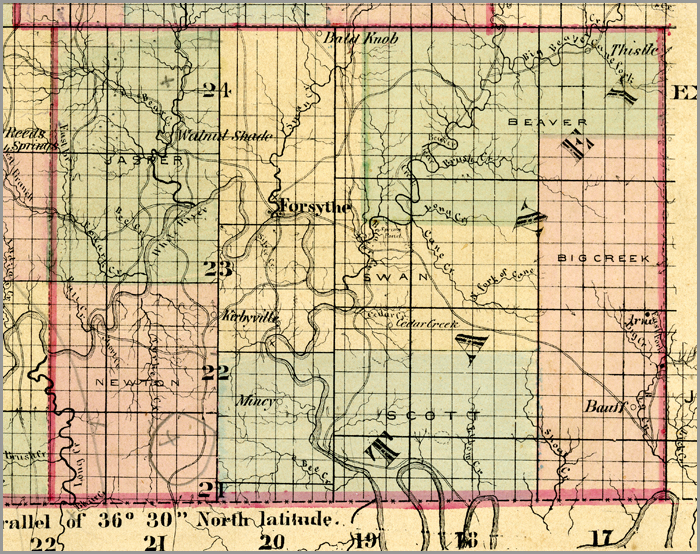Taney County, Missouri

- Formed: 1837
- County Population 1860: 3,494
- Slave Population 1860: 82
- Civil War Engagements
-Skirmish at Forsyth, July 22, 1861
Image courtesy of Wilson’s Creek National Battlefield
Taney County, Missouri was traditionally Osage territory. The Native Americans began to be displaced by first Spanish and then French settlements in the late 18th and early 19th centuries. The area came under the control of the United States in 1803 with the Louisiana Purchase. One of the first Americans to enter the county area was Henry R. Schoolcraft, an explorer who passed through in 1818-1819. When Missouri became a state in 1821, settlers began to move in from Tennessee and Kentucky following the White River.
Taney County is located in the White River Valley and therefore has abundant fertile soil and fresh water. In addition to the White River, the county also contains Bull, Shoal, and Swan Creeks. Taney County was rich in natural lead, sulfur, and zinc deposits and had abundant timber resources. The soil is suitable for growing corn, wheat, and limited amounts of cotton. The bee industry was also successful in Taney County.
Taney County was originally part of Greene County when the latter formed in 1833, but officially formed its own county in 1837. It was named after Roger B. Taney, President Jackson’s Attorney General and United States Supreme Court Justice from 1836-1864. A committee made up of prominent men from surrounding counties formed to pick the county seat—George M. Gibson of Barry County, John Mooney of Polk County, and Thomas Horn of Greene County. Forsyth, named after John Forsyth, President Jackson’s Secretary of State, became the county seat. John W. Hancock established the first post office and became the first postmaster shortly thereafter. The county would gradually become smaller when Stone and Christian Counties were formed out of parts of Taney in 1851 and 1859, respectively.
The 1840s and 1850s were a period of large economic prosperity for Taney County. A commercial lead mine operated in the area during these years, and the fur trade blossomed due to proximity to the White River and easy water travel. Residents traded furs, beef, beeswax, and honey for whiskey, salt, gunpowder, and knives. Because of the fur trade, the steamboat industry also prospered. Timber trade was a large economic force in the county and several commercial sawmills operated in the area.
When unrest began in the Southern states, the question of slavery was not an issue in Taney County. There were very few slaves, only 82 recorded in the 1860 Census, and even fewer slaveholders—with Samuel Gimlin, James Cook, Sr., and James Ellison with most notable holders—in the county. Taney County residents were neutral at the beginning of the war, though none supported Lincoln in the Presidential election of 1860. Confederate troops took control of Forsyth at the beginning of the war and used the county courthouse as their headquarters. In July, 1861, Union troops under General Thomas Sweeney ran the Confederates out. However, after the Union troops left the area Confederates regained control. The Union army was shortly defeated at the Battle of Wilson’s Creek, in Greene County in August. On April 10, 1862, Union General Samuel R. Curtis drove the Confederate army out of Taney County on his way to Arkansas, but as soon as the Union army left, the Confederates once again regained control. By the spring of 1863, the Union army had control of the county. They used the courthouse as their headquarters and stockade it against an impending Confederate attack. However, when the attack never came, the Union army decided to move on. Not wanting to provide a free fortress for the Confederate army, they burned the stockade courthouse, destroying all county records.
After the courthouse’s destruction, county government was on hiatus until the end of the war. Most Taney County residents left during the war—with Union supporters heading further north and Confederate supporters heading further south—to escape the guerrilla warfare that was rampant in the area. Though there were no major battles in Taney County boundaries, the continual changing of control from Confederate to Union hands resulted in much destruction and violence. By 1870, the population was 4,407, compared to the 1850 population of 4,472 people. The Missouri Militia organized in March of 1865 to maintain control until the county government could be reestablished. They did not leave until September.
In the postwar atmosphere, many criminals preyed on those recovering. The Panic of 1873 and a grasshopper plague in 1874 further delayed rebuilding the county, and another courthouse fire in 1885 again destroyed all county records. In the late 19th and early 20th century, the discovery of pearls in White River helps boost the local economy finally began to bring the county out of its postwar slump.
 Browse all collections in Taney County
Browse all collections in Taney County
- Consulted:
- Elmo Ingenthorn, The Land of Taney: A History of an Ozark Commonwealth (Forsyth, MO: White River Valley Historical Society, 1983).












